I went sailing in Santorini! Sunset Oia boat cruise: Greek islands tour, beaches, Ia architecture.

Hello from one of the world’s most fabulous beach destinations: Santorini, Greece! The Mediterranean breeze made me look like RuPaul for a moment…
(I’m dressed in this exact Iron Fist skeleton bones jacket. More items from this fun Gothic brand below).

In my first post from Santorini, I took you inside my luxurious villa overlooking the Mediterranean.
In addition to securing us the perfect stay, Blue Villas Collection helped us arrange activities on the island (they have a concierge service for all their guests).
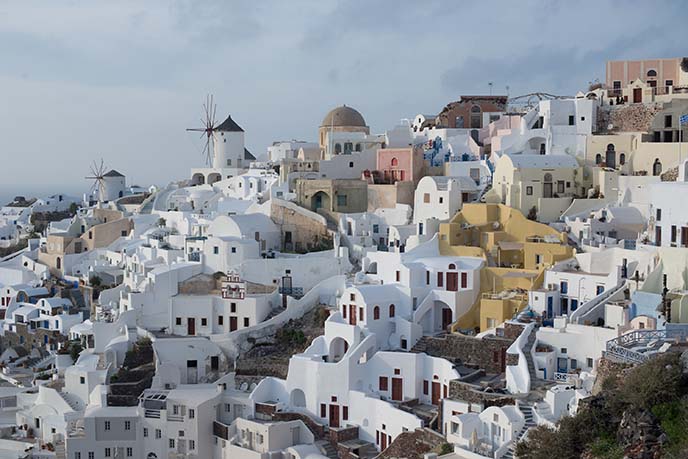
Before and during the trip, our Blue Villas concierge gave us personalized advice to make the most of our Santorini sojourn.
Thanks to her tips, we went to postcard-perfect Oia (Ia) during the best time of day, and relaxed on all the major beaches on the island. (All photos by Joey Wong)
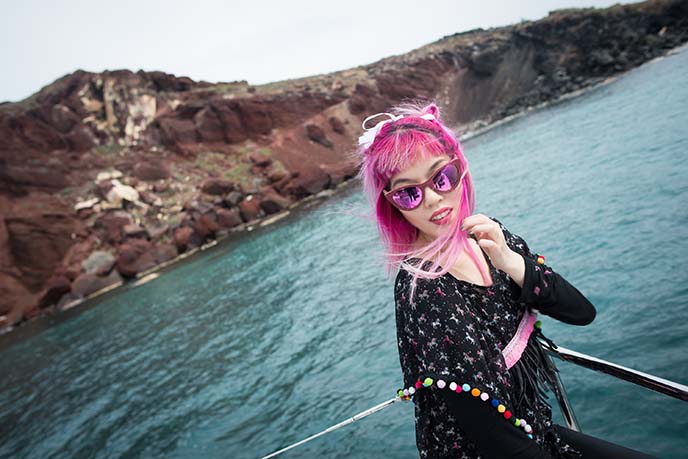
I told our concierge that I wanted to do a sunset sailing trip (when in Greece, one must spend time on the water!). She immediately recommended a half-day cruise with Sunset Oia, the leading company for yacht excursions in Santorini.
♡ Outfit Details ♡ I’m wearing cat-eye sunglasses by Moat House, and a unicorn fringe top by Irregular Choice (it is from the wardrobe of my friend Rose). While my shirt is no longer found online, it’s similar to this Carmen pom pom top and off-shoulder white dress with rainbow pom-poms.

Sunset Oia has a handy shuttle service included in tour packages, which makes it easy to get to the starting point. A driver picked us up right outside our private villa, and took us to Vlychada port. Quite a few colorful, traditional Greek boats were tethered to the pier.

Ahoy, mateys — here comes our Sunset Oia catamaran!
Sunset Oia is a local organizer of luxurious sailing tours, ranging from small group day-trips to romantic private cruises. Their fleet of modern, luxurious yachts brings guests to beautiful spots all around Santorini, including the beaches and therapeutic hot springs.

Joey and I had signed up for a 5-hour water excursion, which departs in the afternoon and stops in multiple locations. We got to dine on fresh Greek food on-board, then watch the sun set while drifting on the Aegean.

Sunset Oia’s friendly and professional crew welcomed us on board, and walked us through safety instructions. We had to remove our shoes and put them in a basket for the duration of the journey — hence the barefoot photos!
For those of you who worry about sea sickness: fear not. We had a smooth ride throughout, with no choppiness. (However, the crew has ginger chews available in case you feel nauseous).
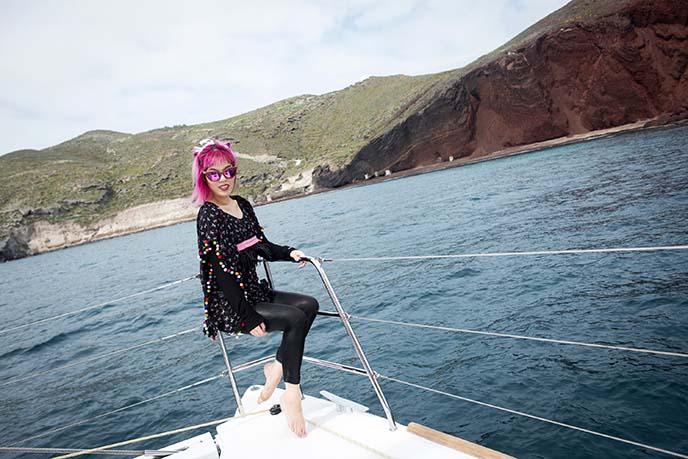
Our Sunset Oia trip stopped in several locations, starting with Akrotiri or Red Beach, famous for its rust-colored cliffs. We weren’t able to get off the boat, but guests had the opportunity to jump overboard and swim or snorkel for about 15-20 minutes.
(As you might expect, I didn’t go into the water — but used this opportunity to sit in the corner seat and take photos!)

On a different day, I took the bus to Red Beach and took these snaps. (Give yourself at least 15 minutes to walk from the bus stop to the beach, and even longer if you go up the hill and down to the larger stretch of sand).
The peculiar rocks originate from volcanic lava, hence the reddish-brown hue.

Akrotiri is also an important archaeological site; starting in the late 19th century, excavators discovered the remains of a Minoan Bronze Age settlement. Above is a curving white church that currently sits near the beach.

I’m a pirate at heart, and love the feeling of sailing o’er the seas. But leave your tricorn hat at home, as it would blow off from the wind. Instead, I wore layers (as it can get chilly), sunglasses, and lots of sunscreen.
– My unicorns top is by Irregular Choice, who are best known for their wildly original shoes. They have heels that look like Cinderella, Snow White and Star Wars Darth Vader for example! Scroll more mind-blowing designs:
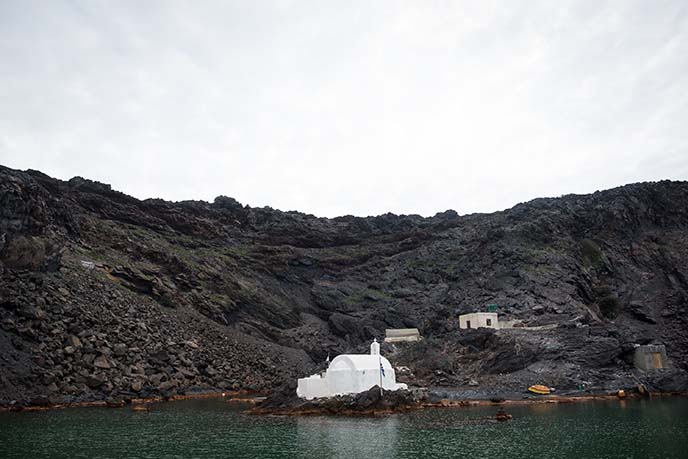
Sunset Oia took us to intriguing spots on Santorini that are only accessible by boat. One of my favorites was this little hideaway, which is inhabited by one hermit. Doesn’t this look like a scene from an alien movie?
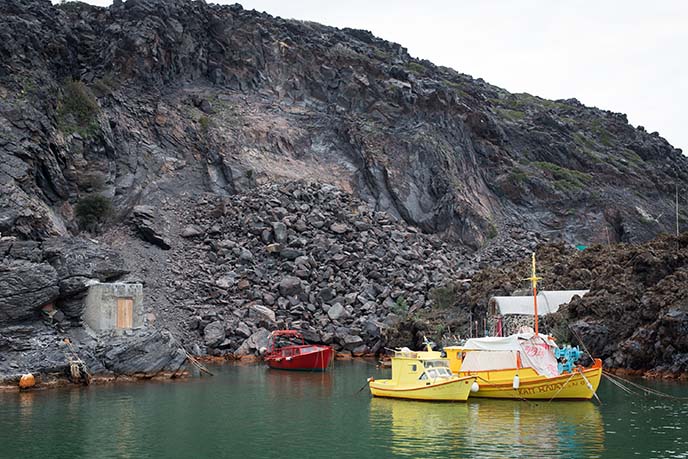
The white church and yellow boats stand out starkly against the dark cliffs. It must feel like being on another planet, living here…
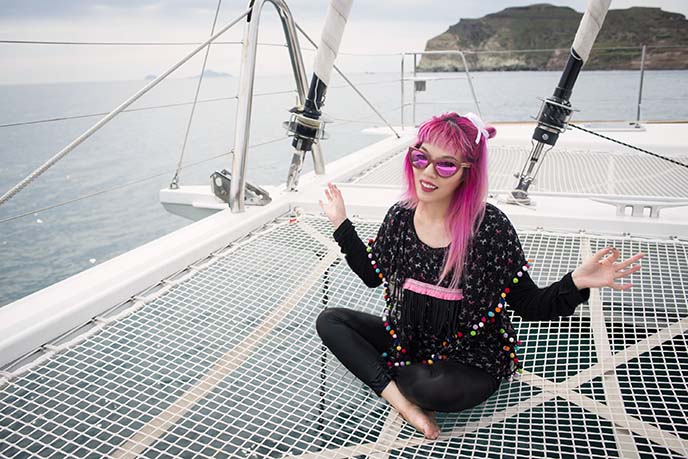
Sunset Oia pipes music out onto the deck, and makes drinks available at all times. This is my happy place: sitting on the tarp, sipping ouzo, watching the horizon…

High up above, we spotted the ancient lighthouse. A day cruise is well worth it, if you’re in Santorini — you can only see views like this here.

Yarr for pom-pom fashion. More designs from Irregular Choice here and below:

The ship’s crew prepared a spread of Greek food for us, including fresh BBQ. I filled my plate with dolmades, tzaziki, Greek salad, Mediterranean pasta… and washed it down with plenty of anise-flavored ouzo, the Greek aperatif that is similar to absinthe. Dessert was slices of green apples, drizzled in Greek honey and cinnamon — so good!

Santorini’s sunsets are infamous for their beauty. I can’t begin to describe the joy of watching the sky change color, from the vantage point of the sea…
As the light faded to black, the catamaran pulled up to the historic port of Ammoudi in the village of Oia. Time to disembark, and board the shuttle to return to our villa.
Thank you Sunset Oia: your sailing experience was 5-stars from start to finish.
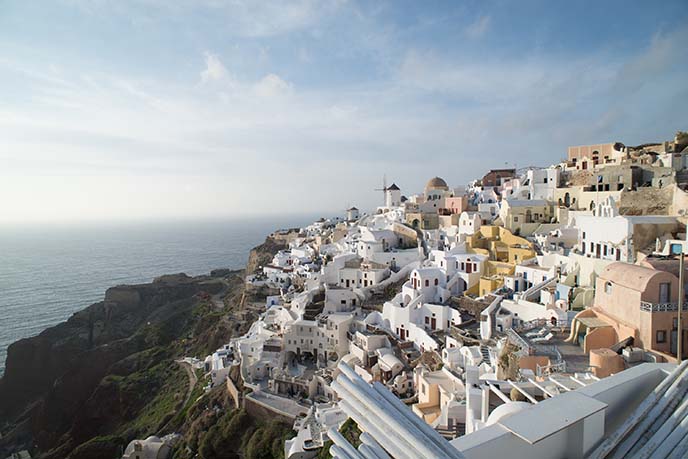
On another day, we traveled by bus to Oia / Ia (pronounced “Eee-yah”), the picturesque village at the top of the island. I suggest coming in the afternoon and making the most of golden hour, before enjoying the sunset.
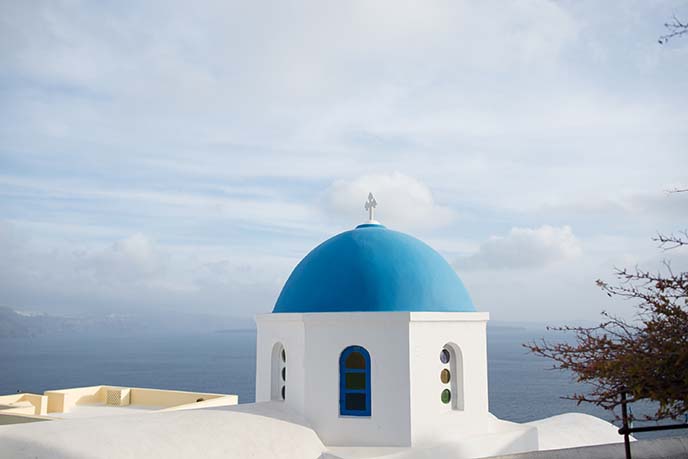
We came right before the start of the spring tourist season, and turned out to be the right decision. The off-season meant we had the streets mainly to ourselves, and didn’t have to jostle with tour buses and tourists. At the same time, the sun was shining on the blue church domes (cupolas).
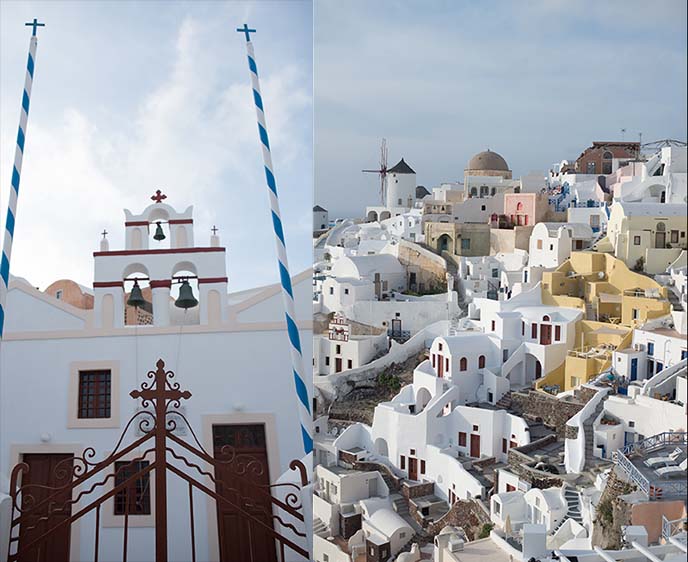
Oia’s pastel and white colored homes are layered onto the high cliffs, and connected by snaking stairs. It’s like gazing upon an MC Escher drawing that meets the laws of nature.
I’m sure you have seen photos of this village before, with classic blue and white Greek Orthodox churches, and an old Aegean sea windmill.

It’s a delight to explore Oia by foot — walking up and down the cobblestone steps, browsing Greek art stores, finding scenic points tucked around corners. Instead of following a map, simply wander and enjoy.
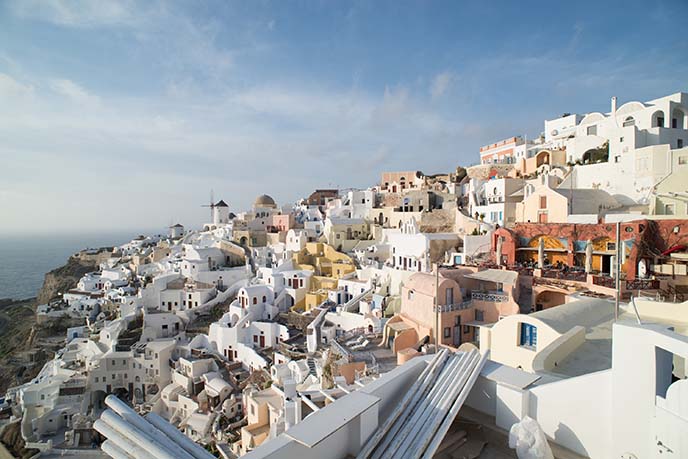
The cozy cave homes look out over the Aegean sea (Blue Villas has vacation rentals here as well). The Cycladic architecture is perfectly suited to its environment, and has lasted throughout the centuries.
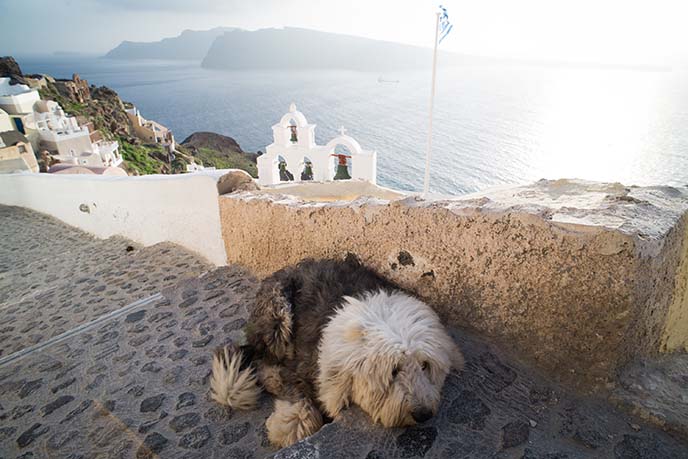
I stopped by a cafe to eat a Greek salad, and watch the clouds pass over the caldera (volcanic crater sunk into the sea). The resident foofy sheepdog stole my heart!

Can you imagine living here, and having these views of the caldera and clear waters year-round?

Santorini’s other major village, Fira (Thira), has equally magnificent viewpoints. I shared photos and took you inside my accommodations, in Part 1 of Santorini.

Magic hour begins, as the sun begins to sink. (Photos by Joey Wong.)

The skies transform into pink, matching my hair.

Not bad, right?

Santorini layers archtecture, cliffs and waters great

No filter needed: the skies naturally turn into these rich, warm hues of pink. However, I suggest that you check the specific sunset time in advance, to avoid rushing and missing out.

Millennial pink and rose gold fans would feel right at home in Oia / Ia.
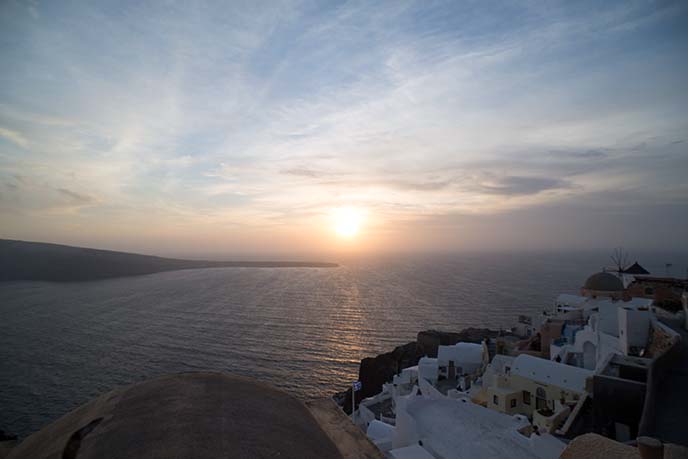
The best sunset viewing locations can get very crowded, especially during the high season. Try to avoid the pack of tour groups, which head to the same spot across from the windmill.
Joey and I found a side street that provided just as magnificent a view. There were only a handful of people next to us — hooray for unobstructed views and no chatterboxes to ruin the moment.

No wonder a Santorini sunset is on the bucket list of many a traveler. The light is radiant and dramatic, and one couldn’t have designed a better natural setting.

One final must-visit spot: Kamari beach, located 10km southeast of Fira and easily reachable by bus. Kamari is known for its black pebbled beach — how Gothic!
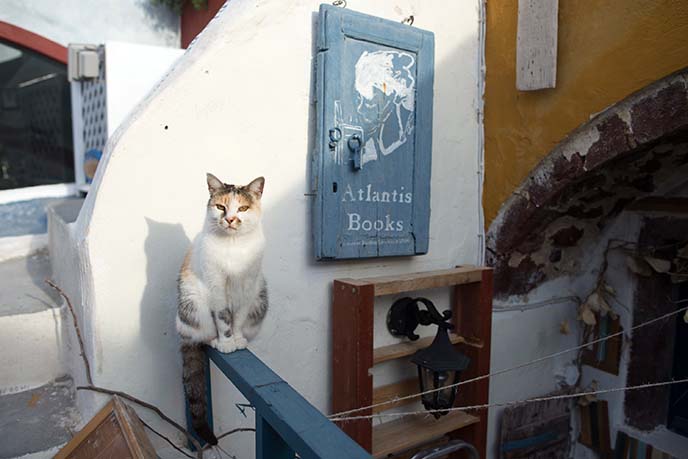
Kamari is next to a little village that is worth a stroll. I said hi to this cat outside Atlantis Books, and stocked up on tins of sardines at the neighborhood grocer.

Kamari has a long, black stretch of beach beneath the gloomy mountain of Mesa Vouno. The water is deep and blue, which gives the shore an unusual contrast.

In 2002, locals discovered an archaic sanctuary dedicated to Achilles. Kamari’s dark volcanic rocks, which range in size from minuscule to massive, are even older.

Doesn’t this look like a prehistoric dinosaur egg? The black rocks are polished by the waves into smooth circles and ovals.

A Goth beach requires a Goth outfit, don’t you agree? I’m wearing this exact Iron Fist jacket; find more styles below…

There’s something about being by the ocean that thoroughly rejuvenates me. Do you feel this way too?

And that’s all she wrote about Santorini. If you’re interested in visiting any Greek island or mainland destinations, check out Discover Greece for lots of tips.

Very grateful to Blue Villas Collection for hosting us in this futuristic-classic cave, and for the seamless daily arrangements. (Take a tour inside this villa in Part 1.)
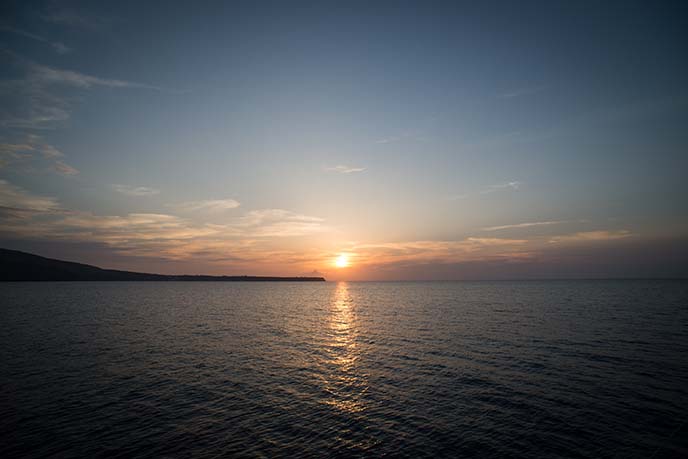
The sun sets on Santorini — but there’s still one more post to come, from Greece.
I’ve saved the Acropolis for last... check back soon for photos from the ancient Athenian temple. And you can see previews of my Austin, Texas trip right now on Instagram @lacarmina.
SHARE & COMMENT
Amsterdam’s coolest fashion & art hotels! Hotel Lloyd & The Exchange, artist themed hotel rooms.

XXX marks the spot! We’re holding crosses because they’re the symbol of Amsterdam. But of course, I made them a tribute to Miffy the Dutch bunny (with her mouth shaped like an X).
My friends and I love experiences that weave together fashion, art and creativity. While in Amsterdam, we stayed in two boutique hotels with rooms customized by artists, ranging from one to five stars. Let us take you inside the stylish Hotel The Exchange…

…and Lloyd Hotel / Cultural Embassy, which feels like a living art installation!
At Lloyd Hotel, I sat down for coffee with co-founder and artistic director Suzanne Oxenaar. We immediately clicked over my Miffy bag, which led to lively conversations about meaningful art, the connection between Dutch and Japanese culture, and her projects around the world.
I loved hearing about Suzanne’s ground-breaking work: she did a pop-up Tokyo “LLove Hotel” with mood-themed rooms by artists, and established a residence for artists at a Netherlands psychiatric institution.

In the mid-1990s, Amsterdam was keen to rejuvenate the Eastern Docklands area, which had become abandoned to squatters. Suzanne and Otto Nan accomplished this by opening Lloyd, the world’s first 1-to-5 star hotel that doubles as a “cultural embassy.” They designed the public spaces to host creatives and guests from around the world, encouraging the exchange of ideas.
(Address: Oostelijke Handelskade 34, 1019 BN Amsterdam, Netherlands)
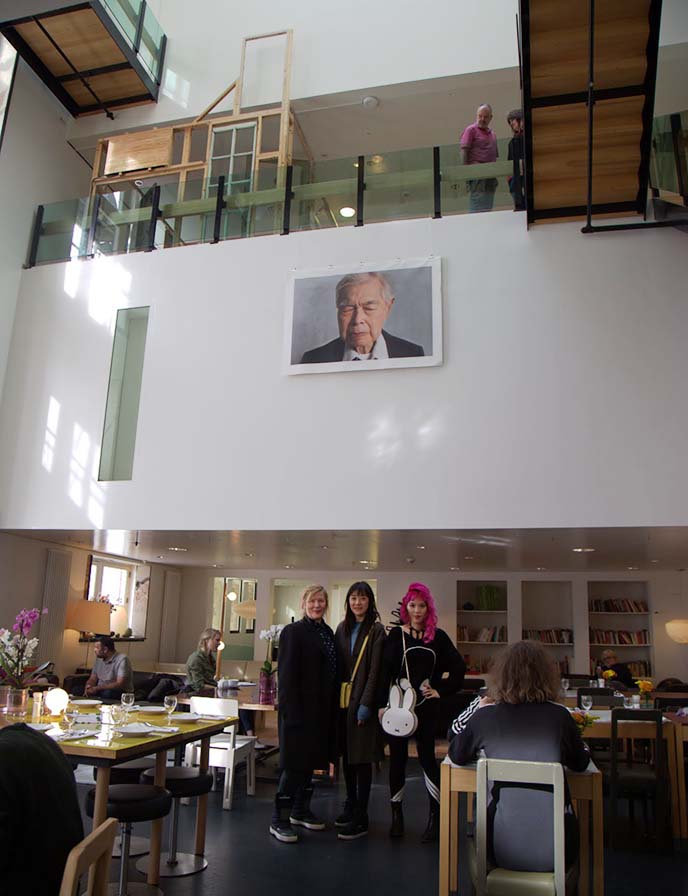
Artists from around the globe come here for residences, or to curate exhibitions. We met the Japanese photographer who created the portrait above. (All photography by Arina Dresviannikova)
Hotel Lloyd’s cultural programs let innovators from different countries connect and collaborate. Most of the works are presented in multi-use spaces that are free and open to the public.

In love with the high ceilings and clean, modern design. Suzanne put care into each detail, such as chairs that were refurbished to be more functional and comfortable, while retaining the original skeleton.
I’ll have to come back to try a meal at Lloyd Restaurant, which serves classic European dishes made with sustainable and organic products.

Lloyd’s meeting rooms and halls are designed to inspire. Guests are encourage to use the spaces however they like, even as exhibition spaces or concert halls.
I felt like I was in Japan during sakura season, thanks to this “Under the Cherry Blossom Tree” installation by Eiko Ishizawa (made from silk screen on textile and wood).
– Outfit Details – My alien sweater is from Gypsy Warrior; it’s similar to this aliens top. Click the thumbnails for more intergalactic options:

Suzanne walked me through the fascinating history of Lloyd Hotel. This historic building was originally commissioned by Royal Holland Lloyd (cargo ship line) to house immigrants. It later became a WWII detention center and refugee camp, and then a prison for young offenders. The space transformed into a collective of artist studios, and finally a design hotel.
Chikako Watanabe, the first artist in residence at Lloyd Culturele Ambassade, made a commemorative installation based on a 1920s room at Lloyd. Families slept on a tiny cot like this, while awaiting their journey on a ship.

I’ve stayed in art / theme hotels before — but none were as creative as the ones at Lloyd Hotel! The 117 rooms are all different, designed by Dutch designers and ranging from 1 to 5 stars (to fit all needs and budgets).
I flopped down on this 8-person bed, inspired by the shenanigans of rock musicians. This “Rough Music Room” is by Joep Van Lieshout, and an example of a five-star deluxe double room.
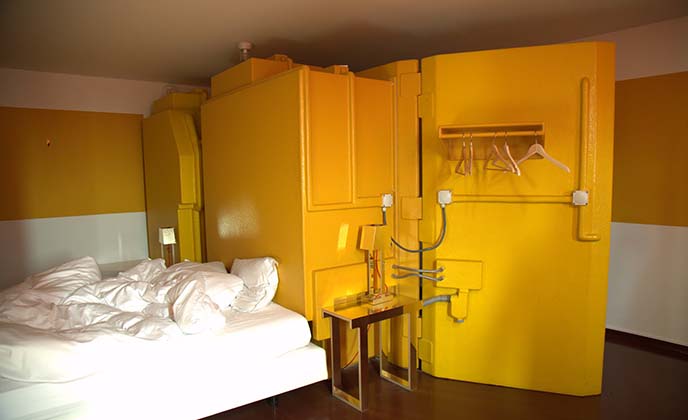
Every room in Lloyd Hotel is unique. When you make a reservation, you can pick the “star category” (which has a corresponding price). The exact room you’ll be staying in is a surprise, unless you make a specific request in advance.
Some of the rooms are very experimental. The one above has a folding, modular hinged wall — which lets you re-arrange the bathtub, closet and partitions as you please!

Lloyd Hotel encourages you to let go and have fun. How could I resist swinging around this rustic attic-style room, with a built-in swing?
My Dutch vlogger frend Leyla, who runs LeylaFashion blog and @leylafashion YouTube channel, created a vlog about our tour of the hotel — you can see us playing around on these swings!
(If you like my alien fashion, check out the items below:)

This is not just a dust ball. It’s “Dust Ball,” an art piece by Japan’s Suchan Kinoshita. Like the Katamari video game, she rolled traces of the hotel’s past into this mound — a preservation and reflection of the building’s many transformations.

Even a 1-star room (top right) is cozy and designed with flair. Each floor contains different room-types, so guests from all backgrounds can mingle.
Suzanne brought us to the library, open to both guests and visitors for exhibitions, lectures, or plain relaxing and reading. The classical space contains a typewriter and furniture by De Bazel, a Dutch architect and contemporary of Frank Lloyd Wright.

I couldn’t help but smile at “The Family Portraits,” an exhibition by Michiel Voet. His photos communicate family stories, and the impact that migration has on society.

The immigrant portraits are a study in friction and togetherness throughout the generations. Now I want to do a family portrait, standing on chairs and with spacesuit-jars over our heads!

Leyla, Arina and I also stayed at Hotel The Exchange — another whimsical property run by Suzanne and her team.
What’s the deal with the XXX, which you’ll see all over Amsterdam? This symbol is from the city’s coat of arms, and represent three vertical St. Andrew’s Crosses. The saint was martyred on an X-shaped cross in the 1st century.
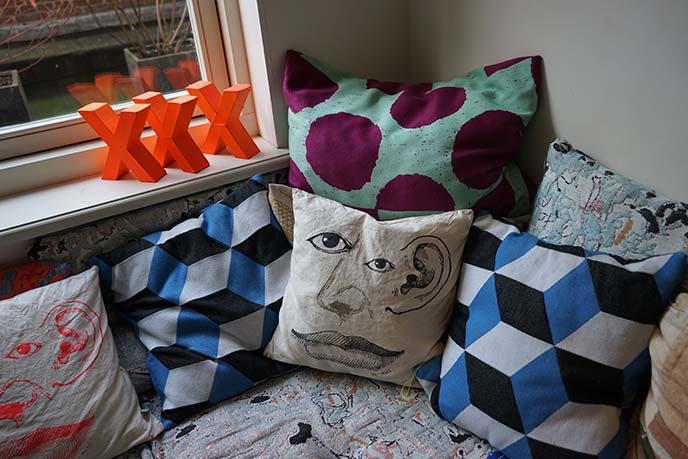
Amsterdam is known for adult entertainment in the Red Light District, which gives “XXX” a coincidental meaning as well. For me, it represents the X-mouth of Miffy, the Dutch mascot!
Hotel The Exchange’s name refers to the weaving together of fashion and interior design, making these rooms one-of-a-kind.

This boutique hotel’s location is ideal for travellers: right in the city center, and within walking distance of all the major sights. (Address: Damrak 50, 1012 LL Amsterdam, Netherlands)
In the spirit of playful collaboration, Otto Nan and Suzanne Oxenaar commissioned students from Amsterdam Fashion Institute to create rooms “dressed like models.” The lounge sets the whimsical tone, with has pillows made from fabric swatches and a selfie #nofilter mirror.

Hotel The Exchange is actually made up of three narrow buildings (one dates back to the 17th century), which were connected while retaining the original framework. The winding staircases and unexpected passages make this a fun space to wander through.
(All photography by Arina Dresviannikova)

Once we checked in, I spread out my belongings on my bed.
Details of my silver clutch by Makeup Junkie Bags, and I Amsterdam city card (which gave me free, unlimited access to public transit and all the major museums in Amsterdam).

We stayed in the top-level Rembrandt Room, featuring this superb view and a bed surrounded by what looks like a giant, old-fashioned ruffled collar.

Closeup on Leyla’s cute accessories: a Hello Kitty ghost ring, and Dutch Pikachu. She uploaded a vlog about our adventures at Lloyd hotel; The Exchange footage is coming soon.

Hotel The Exchange has 61 unique rooms, each with its own theme and designed by a young graduate of AMFI. Like at Lloyd, they range from one to five stars (reflecting the amount of amenities, views and square footage).

The rooms are dressed like models on a catwalk — draped in hand-crafted designs that reflect a particular vision of Amsterdam fashion. In a world filled with cookie-cutter hotels, it’s heartening to stay in a place where you wake up feeling stylish and inspired.

I was impressed by the diversity of design. The “Mattress Room” by Roos Soetekouw deconstructs a bed into its foam, box-spring and textile parts. These pieces are re-worked into 3D furniture and textured decor. I think my Miffy purse looks quite at home on this hanger rack, made out of bed-springs.

Even the room numbers get a twist: each is a hand-embroidered disk, made up of X’s in the hotel’s signature orange-red shade.

Malu Gehner called her room “Epaulettes,” after the shoulder decorations found in military attire. Her room is decked out in braided rope trimmings.
Many of the artists incorporated special fabrics developed in collaboration with the Textile Museum in Tilburg for the project.

Roos Soetekouw created one of my favorite rooms, “Misunderstood Creatures.” This is not for everyone, but you can understand why Goths would feel right at home.
The sinister fantasy installation includes portraits of three troubled yet lovely creatures. The black ceiling seems to be crying dark tears.
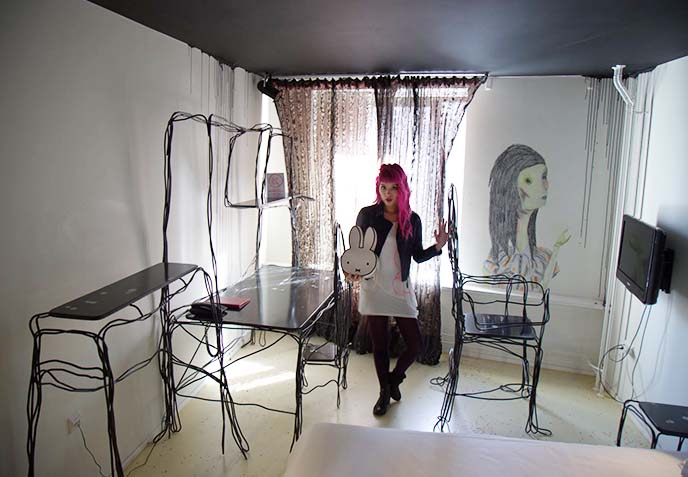
I love the dark side of fashion, and The Room of Misunderstood Creatures spoke to my aesthetics.
If you look closely, there are colorful sequins encased in the floor — adding a magical sparkle to the twisted gloom.

Sofie Sleumer was inspired by the tales of the brothers Grimm. She used the walls of her small room to tell the story: a collage of nature, insects, eggs and other fairytale imagery. She also sourced broken furniture from small markets, mending the broken parts to add to the feeling.

Hotel The Exchange has several common areas for guests. This one has a wide selection of fashion and photography books, and two working sewing machines, fabric and threads!

Every morning, we looked forward to having breakfast at hotel’s Café Stock located next door. The well-lit space has illustrations from the room designers on the walls.
Arina and I couldn’t get enough of Cafe Stock’s Dutch apple pie, baked fresh and served with real hand-whipped cream. We always ordered the XL sized lattes and cheese pancakes, and the national “stroopwafel” (two pieces of thin, baked waffle with caramel syrup in between) is a must-try.

Cheers to Hotel The Exchange and Lloyd Hotel / Cultural Embassy for the inspiring stay. Hearts and stars to I Amsterdam for making these stories possible.

Would you stay in a fashion hotel like this one?
Don’t forget to check out Leyla’s vlog of our hotel tour, and more of my travel tips from the Netherlands here. And I’m now off to a new destination… check out my Instagram to see where I’ll be. Hint, yee-haw!

 LA CARMINA
LA CARMINA






